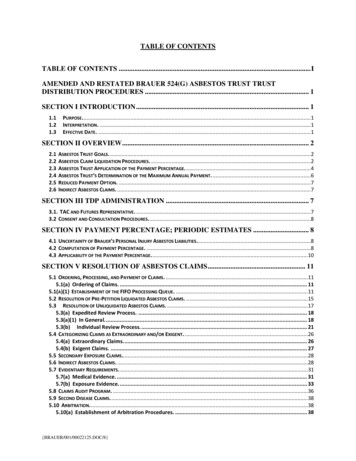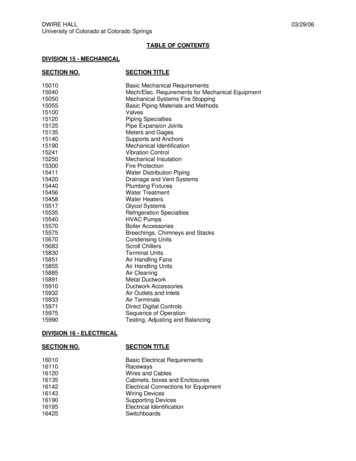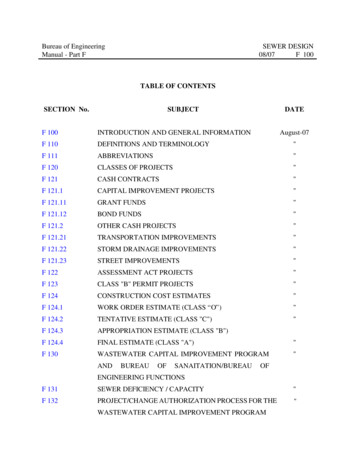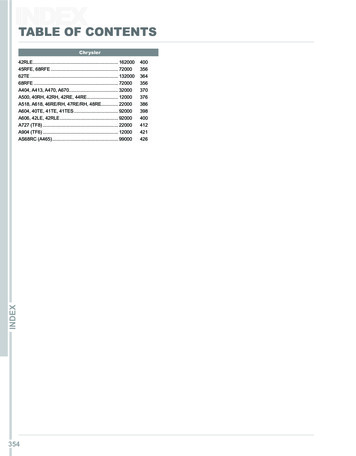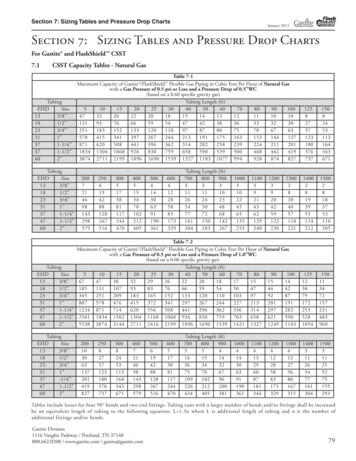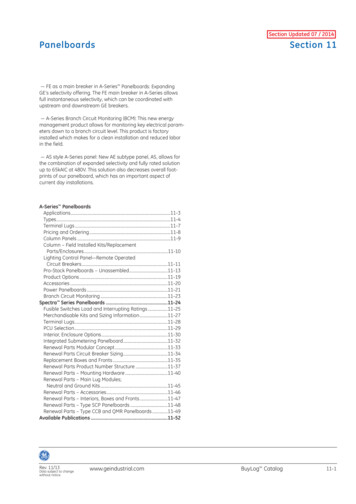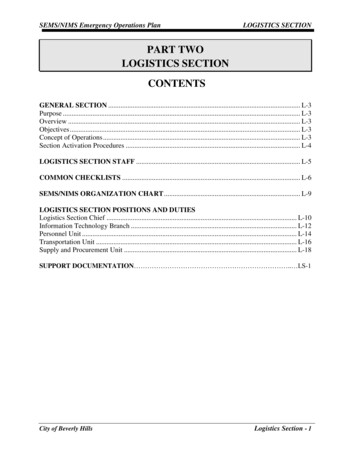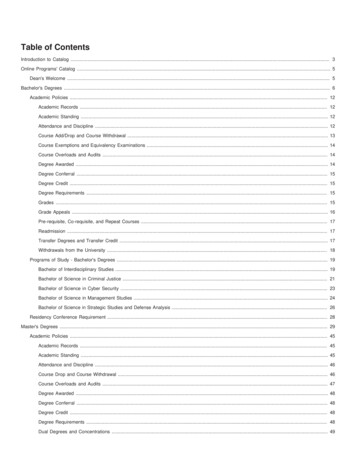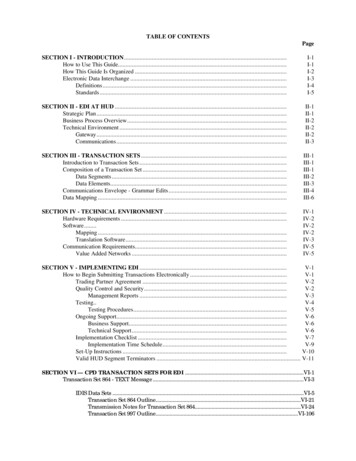
Transcription
TABLE OF CONTENTSPageSECTION I - INTRODUCTION.How to Use This Guide.How This Guide Is Organized .Electronic Data Interchange .Definitions.Standards.I-1I-1I-2I-3I-4I-5SECTION II - EDI AT HUD .Strategic Plan.Business Process Overview.Technical Environment CTION III - TRANSACTION SETS .Introduction to Transaction Sets .Composition of a Transaction Set .Data Segments .Data Elements.Communications Envelope - Grammar Edits.Data Mapping .III-1III-1III-1III-2III-3III-4III-6SECTION IV - TECHNICAL ENVIRONMENT .Hardware Requirements .Software.Mapping .Translation Software.Communication Requirements.Value Added Networks .IV-1IV-2IV-2IV-2IV-3IV-5IV-5SECTION V - IMPLEMENTING EDI .V-1How to Begin Submitting Transactions Electronically .V-1Trading Partner Agreement .V-2Quality Control and Security.V-2Management Reports .V-3Testing.V-4Testing Procedures.V-5Ongoing Support.V-6Business Support.V-6Technical Support.V-6Implementation Checklist .V-7Implementation Time Schedule.V-9Set-Up Instructions .V-10Valid HUD Segment Terminators . V-11SECTION VI — CPD TRANSACTION SETS FOR EDI .VI-1Transaction Set 864 - TEXT Message .VI-3IDIS Data Sets .VI-5Transaction Set 864 Outline.VI-21Transmission Notes for Transaction Set 864.VI-24Transaction Set 997 Outline.VI-106
APPENDIXA.A-1Internet Access . A-1APPENDIX B. B-1Basic Trading Partner Agreement . B-1Addendum for CPD Transaction Sets. B-7APPENDIX C. C-1HUD Communications Envelope Specifications . C-1APPENDIX D.D-1Transaction Sets for Text Message & Functional Acknowledgment .D-1Transaction Set 864 Outline .D-1Transaction Set 997 Outline .D-1REFERENCESGLOSSARY
SECTION I — INTRODUCTIONElectronic Data Interchange (EDI) is the inter-organizational exchange of businessdocuments in a pre-defined structured format. It is accomplished by the computer-tocomputer exchange of standard formatted business transactions between one or morebusiness partners, known as trading partners. EDI permits trading partners togenerate, receive, and process data with little or no human intervention.EDI is an important component of continuing initiatives within the Office ofCommunity Planning and Development (CPD) for the Department of Housing andUrban Development (HUD) to improve the effectiveness and efficiency of governmentprograms through the use of electronic information systems technology.The EDI projects are conducted under the direction of HUD's Office of InformationTechnology (IT). The Office of Information Technology is responsible for providingpolicy direction and coordination for HUD's EDI effort.The purpose of this Implementation Guide is to provide the information necessary toexchange business documents electronically with HUD.How to Use This GuideThis Implementation Guide provides an overview of EDI, including definitions andstandards; hardware, software, and communications requirements; and a step-by-stepapproach to implementing EDI technology. It is designed to introduce HUD tradingpartners to EDI, how EDI works at HUD, and the elements needed to successfullyimplement EDI in transacting business with HUD. Sections I to V cover the generalconcepts and elements of EDI. Sections VI and VII focus on specific EDI transactionsets used to electronically exchange business documents and the tools helpful toimplement each. The following tools are provided with Section VI, VII andAppendices to aid in understanding and implementing EDI transaction set(s) in lieu ofcurrent business transactions with HUD:Ø Transaction Set Outline;Ø Transmission Notes;Ø Data Mapping Guide;Ø Cross Reference Matrix (where applicable); andØ Adjunct Transaction Sets for your particular transaction set.
How This Guide Is OrganizedThis Guide is divided into seven sections plus appendices, designed toanswer a wide range of questions involving the business and operationalconsiderations, and the technical requirements for implementing EDI withinHUD.Section I provides an introduction to EDI definitions and concepts, includingthe benefits of EDI, standards, and functional requirements.Section II discusses the specifics of EDI use at HUD, including HUD'sstrategic plan for EDI implementation and the impact of EDI on HUDbusiness processes.Section III provides an introduction to the electronic form of HUD businessdocuments (transaction sets) and the components of a transaction set.Section IV specifies the technical requirements for implementing EDI,including hardware, software, and telecommunications specifications.Section V provides the operational, procedural, and management details forimplementing EDI in your organization, including Trading PartnerAgreements and Addendums, as well as the implementation time schedule.Section VI provides specific information on the mapping guides andbusiness scenarios for the reporting of program data in an electronic format.Appendix A contains HUD's address for the Internet.Appendix B contains the Trading Partner Agreement with the addendum fortrading with the Office of Community Planning and Development.Appendix C contains the specifications for the HUD communicationsenvelope.Appendix D contains the adjunct transaction sets that apply to all transactionsets used by CPD.References and Glossary sections are also provided. The References sectionlists standards and other documents used in conjunction with EDI while theGlossary defines terms related to EDI.
Electronic Data InterchangeEDI is the direct computer-to-computer exchange of standard formattedbusiness transactions between one or more mutually agreeable businesspartners. With EDI, standard business documents that were previously senton paper through the mail can be transmitted instantaneously usingtelecommunication capabilities.Because transmissions are sent in astandardized, computer-readable format, the time-consuming and errorprone re-keying of information into the receiver's computer system isunnecessary — the document goes directly from one information system toanother. EDI is "paperless trading."Figure I-1Without EDIEDI includes the direct transmission of data between organizations (bothsending and receiving) using an intermediary such as a value addedcommunication network. EDI is not facsimile transmission of information noris it electronic mail. Both of these transmission types are in free format (notstandard format) and, therefore, generally require re-keying of data into acomputer system.
Figure I-2With EDIThe benefits of EDI include:Ø Time savings and associated financial savings accrued from:······Reduced document processing and transmittal costs;Elimination of keying of redundant information;Reduction of manual reconciliation of information;Correction of data entry errors;Sorting, distribution, and filing of documents; andDocument mailing or telephoning of information;Ø Improved accuracy;Ø Improved trading partner relationships and client interactions; andØ Improved reconciliation of transactions exchanged.
DefinitionsTo understand EDI, it is important to have a brief introduction to a variety ofterms and acronyms that are used in any discussion of EDI.Trading Partner — A trading partner is any company, governmentdepartment, or commercial or noncommercial entity with whom anorganization regularly exchanges documents of formatted data (not justletters or memos).Trading Partner Agreement — This document outlines all the conditionsthat will allow electronic communication between trading partners. Theagreement states that the parties intend to operate in the same manner asthough they were exchanging hardcopy paper documents, with the signatureon the agreement serving as a substitute for signature of each paper-basedbusiness document previously submitted.Mapping — The process of taking data from a company-specific format andfitting it to the EDI standard format (transaction set).Transaction Set — A standard format EDI business document.Translation Software — Software used to take data from a flat file and into astandard EDI format.Value Added Network (VAN) — A third party network performing servicesbeyond the transmission of data. For example, VANs provide mailbox, datasecurity, and data archiving services.Van Interconnect — The connection between two third party networks thatallows messages from one to be communicated to the other.The glossary provided as a part of this guide contains a more comprehensivelist of EDI terms and relevant acronyms.StandardsEDI standards are agreements between users of EDI on how data is to beformatted and communicated. Standards are key to both the effectivenessand integrity of EDI. These standards are embodied in the electronic formatof business documents known as transaction sets. The standards used byHUD are the ANSI ASC X12 standards, abbreviated herein as X12.
Standards provide a common syntax, set of rules, and procedures for theirmaintenance and enhancements. EDI standards presently define andsupport more than 200 business documents derived from industry andgovernment working groups. They provide a framework from which newstandards can be derived as well as a data base of elements to be used in thecreation of new standards.In general, EDI formatting standards address the following issues:Ø What documents can be communicated electronically;Ø What information is to be included;Ø What sequence the information should follow;Ø What form the information (i.e., numeric, ID codes, etc.) should use; andØ The meaning of the individual pieces of information.To meet the emerging requirements for standard EDI protocols, theAmerican National Standards Institute (ANSI) chartered AccreditedStandards Committee (ASC) X12 to develop uniform standards for EDI. TheX12 data structure is based on a proven methodology for adapting businessforms for electronic transmission across telecommunication networks. Agroup of standards subcommittees are in place to advise, critique, andmonitor the development of all X12 formats and make these formatsavailable for business or government use.The Data Interchange Standards Association (DISA) was formed in 1986 toencourage the use of X12 standards. This organization is the administrativesecretariat for the X12 organization. It provides services such as printing,distribution, and storage of standards. Additionally, DISA participates in theinternational development of standards working with EDI forAdministration, Commerce, and Trade (EDIFACT). EDIFACT is a family ofstandards sponsored by the United Nations. These standards are emergingas the medium for global electronic trade.For the Federal Government, the National Institute of Standards andTechnology (NIST), issued Federal Information Processing Standard (FIPS)161, Electronic Data Interchange (EDI). FIPS 161 adopts the ASC X12standards as mandatory for use by the Federal Government for any EDIinitiative implemented after September 30, 1991. In compliance with thisFederal standard, HUD is committed to using X12 standards in allDepartment initiatives involving EDI.
SECTION II — EDI AT HUDThe U.S. Department of Housing and Urban Development (HUD) is committed toimplementing direct computer application-to-computer application exchange ofstandardized information between private industry and HUD. EDI is widelyrecognized as a strategic information systems technology in both the private sector andwithin the Federal Government.The HUD Office of Information Technology (IT) has selected the processing ofProgram Data as its first EDI opportunity. The use of EDI will reduce excessive, timeconsuming, paper processing by both the Grantee (HUD Recipient) and HUDHeadquarters staff; thereby improving service to the community while increasingaccuracy and allowing for more timely reporting.This section of the guide provides the strategic initiatives under which EDI applicationshave been developed and the business process they support.Strategic PlanWherever possible and feasible, HUD is committed to the use of EDI in all programand administrative initiatives that require high volume, paper-based, frequentlyrecurring submissions to the Department from private and/or public sector sources.The HUD EDI Strategic Plan sets forth the following objectives to be achieved for theimplementation of EDI capabilities within the Office of Community Planning andDevelopment:Ø Explore the feasibility of applying EDI to the business practices of the Department;Ø Create a formalized process that will facilitate central administration of EDI usagewithin HUD;Ø Establish liaison within and external to the Federal Government to maintaincurrency in the use and advances of EDI technology; andØ Become an active participant within the national EDI standards committees topromote the interests of HUD programs.EDI can be viewed as an enabling technology to be assimilated normally into the HUDbusiness environment. It should be viewed as an enterprise capability that facilitateselectronic communications (connectivity) between HUD and those clients whoroutinely file reports and/or submit prescribed, formatted requests for HUD programservices.EDI is not just a technical solution to automate an otherwise manual or semiautomated business process. It is an opportunity to rethink the way business isconducted with an attempt to promote productivity improvements.
Business Process OverviewThe need to eliminate or reduce paperwork with an emphasis toward increasing theproductivity of the Federal Government has never been greater. The impetus, firstsparked by enactment of the Paperwork Reduction Act of 1980, is being realizedthrough the use of innovative technologies such as EDI. The potential uses of EDIwithin HUD are likewise substantial.EDI can be of significant benefit both to HUD and to any faction of the housingindustry upon which HUD has imposed a repetitive, volume-intensive reportingrequirement. Conversely, substantial benefits may also be derived by both HUD andprivate industry where HUD supplies a service, such as in satisfaction of mortgageinsurance claims.Technical EnvironmentThis subsection of the guide describes the features of the HUD-specific solution forEDI implementation. It is provided as information only and does not prescribe thecomponents of the trading partner solution.The technical environment employed at HUD includes:ØA gateway or front-end processor; andØ The communication capabilities of a value added network (VAN).GatewayAll CPD EDI solutions call for a gateway. The gateway consists of both hardware andsoftware configured to interact wit
Mapping — The process of taking data from a company-specific format and fitting it to the EDI standard format (transaction set). Transaction Set — A standard format EDI business document. Translation Software — Software used to t
